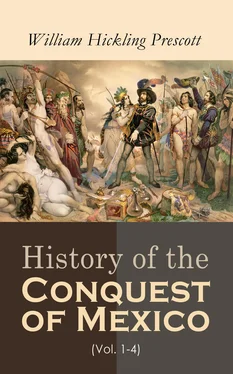Notwithstanding these objections, I have been induced to continue the narrative, partly from deference to the opinion of several Spanish scholars, who considered that the biography of Cortés had not been fully exhibited, and partly from the circumstance of my having such a body of original materials for this biography at my command. And I cannot regret that I have adopted this course; since, whatever lustre the Conquest may reflect on Cortés as a military achievement, it gives but an imperfect idea of his enlightened spirit and of his comprehensive and versatile genius.
To the eye of the critic there may seem some incongruity in a plan which combines objects so dissimilar as those embraced by the present history, where the Introduction, occupied by the antiquities and origin of a nation, has somewhat the character of a philosophic theme, while the conclusion is strictly biographical , and the two may be supposed to match indifferently with the main body, or historical portion of the work. But I may hope that such objections will be found to have less weight in practice than in theory; and, if properly managed, that the general views of the Introduction will prepare the reader for the particulars of the Conquest, and that the great public events narrated in this will, without violence, open the way to the remaining personal history of the hero who is the soul of it. Whatever incongruity may exist in other respects, I may hope that the unity of interest , the only unity held of much importance by modern critics, will be found still to be preserved.
The distance of the present age from the period of the narrative might be presumed to secure the historian from undue prejudice or partiality. Yet by the American and the English reader, acknowledging so different a moral standard from that of the sixteenth century, I may possibly be thought too indulgent to the errors of the Conquerors; while by a Spaniard, accustomed to the undiluted panegyric of Solís, I may be deemed to have dealt too hardly with them. To such I can only say that, while, on the one hand, I have not hesitated to expose in their strongest colors the excesses of the Conquerors, on the other, I have given them the benefit of such mitigating reflections as might be suggested by the circumstances and the period in which they lived. I have endeavored not only to present a picture true in itself, but to place it in its proper light, and to put the spectator in a proper point of view for seeing it to the best advantage. I have endeavored, at the expense of some repetition, to surround him with the spirit of the times, and, in a word, to make him, if I may so express myself, a contemporary of the sixteenth century. Whether, and how far, I have succeeded in this, he must determine.
For one thing, before I conclude, I may reasonably ask the reader’s indulgence. Owing to the state of my eyes, I have been obliged to use a writing-case made for the blind, which does not permit the writer to see his own manuscript. Nor have I ever corrected, or even read, my own original draft. As the chirography, under these disadvantages, has been too often careless and obscure, occasional errors, even with the utmost care of my secretary, must have necessarily occurred in the transcription, somewhat increased by the barbarous phraseology imported from my Mexican authorities. I cannot expect that these errors have always been detected even by the vigilant eye of the perspicacious critic to whom the proof-sheets have been subjected.
In the Preface to the “History of Ferdinand and Isabella,” I lamented that, while occupied with that subject, two of its most attractive parts had engaged the attention of the most popular of American authors, Washington Irving. By a singular chance, something like the reverse of this has taken place in the composition of the present history, and I have found myself unconsciously taking up ground which he was preparing to occupy. It was not till I had become master of my rich collection of materials that I was acquainted with this circumstance; and, had he persevered in his design, I should unhesitatingly have abandoned my own, if not from courtesy, at least from policy; for, though armed with the weapons of Achilles, this could give me no hope of success in a competition with Achilles himself. But no sooner was that distinguished writer informed of the preparations I had made, than, with the gentlemanly spirit which will surprise no one who has the pleasure of his acquaintance, he instantly announced to me his intention of leaving the subject open to me. While I do but justice to Mr. Irving by this statement, I feel the prejudice it does to myself in the unavailing regret I am exciting in the bosom of the reader.
I must not conclude this Preface, too long protracted as it is already, without a word of acknowledgment to my friend George Ticknor, Esq., the friend of many years,—for his patient revision of my manuscript; a labor of love, the worth of which those only can estimate who are acquainted with his extraordinary erudition and his nice critical taste. If I have reserved his name for the last in the list of those to whose good offices I am indebted, it is most assuredly not because I value his services least.
William H. Prescott.
Boston, October 1, 1843.
Note.—The author’s emendations of this history include many additional notes, which, being often contradictory to the text, have been printed between brackets. They were chiefly derived from the copious annotations of Don José F. Ramirez and Don Lúcas Alaman to the two Spanish translations published in Mexico. There could be no stronger guarantee of the value and general accuracy of the work than the minute labor bestowed upon it by these distinguished scholars.—K.
BOOK I
INTRODUCTION
VIEW OF THE AZTEC CIVILIZATION
Table of Contents
MAP OF THE COUNTRY TRAVERSED BY THE
FOR PRESCOTT’S HISTORY
Table of Contents
ANCIENT MEXICO—CLIMATE AND PRODUCTS—PRIMITIVE RACES—AZTEC EMPIRE
OF all that extensive empire which once acknowledged the authority of Spain in the New World, no portion, for interest and importance, can be compared with Mexico;—and this equally, whether we consider the variety of its soil and climate; the inexhaustible stores of its mineral wealth; its scenery, grand and picturesque beyond example; the character of its ancient inhabitants, not only far surpassing in intelligence that of the other North American races, but reminding us, by their monuments, of the primitive civilization of Egypt and Hindostan; or, lastly, the peculiar circumstances of its Conquest, adventurous and romantic as any legend devised by Norman or Italian bard of chivalry. It is the purpose of the present narrative to exhibit the history of this Conquest, and that of the remarkable man by whom it was achieved.
But, in order that the reader may have a better understanding of the subject, it will be well, before entering on it, to take a general survey of the political and social institutions of the races who occupied the land at the time of its discovery.
The country of the ancient Mexicans, or Aztecs as they were called, formed but a very small part of the extensive territories comprehended in the modern republic of Mexico. [4]Its boundaries cannot be defined with certainty. They were much enlarged in the latter days of the empire, when they may be considered as reaching from about the eighteenth degree north, to the twenty-first, on the Atlantic; and from the fourteenth to the nineteenth, including a very narrow strip, on the Pacific. [5]In its greatest breadth, it could not exceed five degrees and a half, dwindling, as it approached its southeastern limits, to less than two. It covered, probably, less than sixteen thousand square leagues. [6]Yet such is the remarkable formation of this country, that, though not more than twice as large as New England, it presented every variety of climate, and was capable of yielding nearly every fruit, found between the equator and the Arctic circle.
Читать дальше












